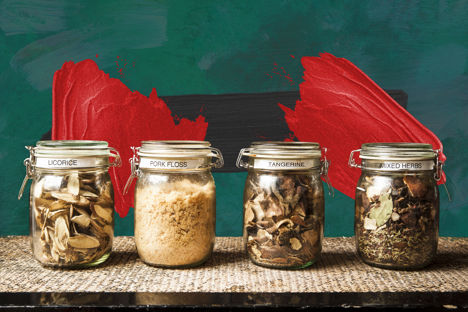
Painting a picture: 'Postcard from Yunnan'
Mukta Das and Andrew Wong talk about the very unique Chinese region of Yunnan, regarded as a wild subtropical frontier full of exotic ingredients such as bananas and truffles, before creating a delicious dessert in homage to its bounty.
Painting a picture: 'Postcard from Yunnan'
Mukta Das and Andrew Wong talk about the very unique Chinese region of Yunnan, regarded as a wild subtropical frontier full of exotic ingredients such as bananas and truffles, before creating a delicious dessert in homage to its bounty.
It’s easy to typecast Chinese cuisine from a British perspective – the vast majority of takeaways and restaurants we’ve eaten at offer a somewhat warped and anglicised version of mostly Cantonese dishes. While we’re starting to appreciate the incredible variety of food enjoyed across China’s many provinces, much of it still remains an unknown. Yunnan is a fantastic example of this; the southwestern region borders Vietnam, Myanmar and Laos and has a very different feel to what we normally think of as ‘China’. Food Anthropologist Mukta Das and Michelin-starred chef Andrew Wong take a closer look at the wild, frontier area of Yunnan, creating a dessert to encapsulate what makes it stand out from the rest of the country. See what they came up with below.
Luo Yuejiong, 1591, Xianbinlu [Record of all the tributaries], Juan [scroll] 8, translated from Chinese in Fiskesjo M. 1999. On the Raw and the Cooked Barbarians of Imperial China. Cambridge: White Horse Press. p143
Andrew Wong: I love the above quote and how it describes Yunnan, written by early Han ethnographers from the sixteenth century. For thousands of years, the southwestern province of Yunnan wasn’t part of China, and even after the 1200s when it was officially incorporated into the nation, Yunnan kept its ‘Wild West’ feel. Mukta told me that people in Yunnan would hide in the local banana plantations to get way from the Han when they were trying to conquer the area. The most interesting thing about this is that bananas have been grown in China for centuries – some species of banana actually originate in the country. Today, cultural groups in Yunnan really treasure their history and stories like this, holding the humble banana in high regard. That was the main inspiration for this dish.
Mukta Das: Anthropologists in the twentieth century noted that a local ethnic minority group called the Lahu worshipped banana trees in their new year celebrations. Banana leaves were an important cooking vessel and banana flowers an important ingredient in the region. There are lots of food-related origin stories in Yunnan because the region is home to a lot of interesting ingredients that we don’t traditionally think of as Chinese – bananas, truffles and wild mushrooms, for example. Yunnan became part of China relatively late on, but it was always regarded as a ‘bread basket’ of exotic ingredients before that. The region has always had this reputation for being a kind of outlier from mainstream Chinese gastronomic thought.
AW: We’ve always been really curious about this idea that Yunnan is one of the only places in China where you can find wild truffles. So you get bananas, which obviously require a very particular climate, and then truffles, which require a very different climate – but both of them grow in a single area. I thought about representing this in a dessert, but needed another element to make it complete. Mukta told me that the French introduced coffee to Yunnan as an export commodity, and there’s this general consensus that if you can grow bananas and coffee in an area, you can probably grow cacao too. I did a lot of research and found one or two small pockets where cacao is grown. Is it a massive thing? No, but it means a dessert of chocolate, banana and truffle represents the region well. It is quite unusual but very delicious.
MD:It's a bit of a running joke between Andrew and I, as whenever he wants to know more about an interesting Chinese ingredient, I'm always digging into Yunnan. It's got this unique subtropical climate not too dissimilar to Vietnam, which is why you get these ingredients that aren’t like what you’d find in the rest of China. It’s not clear if the French also set up cacao plantations when they introduced coffee to the region, but there's a massive coffee culture in today’s China and a lot of that is grown in Yunnan.

